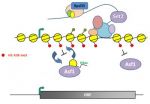Patients with anorexia judge own body size inaccurately, view others' accurately
2012-08-23
(Press-News.org) Patients with anorexia have trouble accurately judging their own body size, but not others', according to research published Aug. 22 in the open access journal PLOS ONE.
In the study, led by Dewi Guardia of the University Hospital of Lille in France, 25 patients with anorexia and 25 controls were shown a door-like aperture and asked to judge whether or not it was wide enough for them to pass through, or for another person present in the room to pass through. In previous similar experiments, anorexic patients felt they could not pass through the door even when it was easily wide enough, and in the current study, the researchers found that the anorexic patients were more accurate at judging others' ability to pass through the aperture than their own. They also found a correlation between the perception of their own ability to pass through the aperture and their body size prior to becoming anorexic, suggesting that the patients may still think of themselves as their previous size.
INFORMATION:
Citation: Guardia D, Conversy L, Jardri R, Lafargue G, Thomas P, et al. (2012) Imagining One's Own and Someone Else's Body Actions: Dissociation in Anorexia Nervosa. PLoS ONE 7(8): e43241. doi:10.1371/journal.pone.0043241
Financial Disclosure: The present work was funded by the Fe´de´ration pour la Recherche Me´dicale. The funders had no role in study design, data collection and analysis, decision to publish, or preparation of the manuscript.
Competing Interest Statement: The authors have declared that no competing interests exist.
PLEASE LINK TO THE SCIENTIFIC ARTICLE IN ONLINE VERSIONS OF YOUR REPORT (URL goes live after the embargo ends):
http://dx.plos.org/10.1371/journal.pone.pone.0043241
Disclaimer: This press release refers to upcoming articles in PLOS ONE. The releases have been provided by the article authors and/or journal staff. Any opinions expressed in these are the personal views of the contributors, and do not necessarily represent the views or policies of PLOS. PLOS expressly disclaims any and all warranties and liability in connection with the information found in the release and article and your use of such information.
About PLOS ONE
PLoS ONE is the first journal of primary research from all areas of science to employ a combination of peer review and post-publication rating and commenting, to maximize the impact of every report it publishes. PLOS ONE is published by the Public Library of Science (PLOS), the open-access publisher whose goal is to make the world's scientific and medical literature a public resource.
All works published in PLOS ONE are Open Access. Everything is immediately available—to read, download, redistribute, include in databases and otherwise use—without cost to anyone, anywhere, subject only to the condition that the original authors and source are properly attributed. For more information about PLOS ONE relevant to journalists, bloggers and press officers, including details of our press release process and our embargo policy, see the everyONE blog at http://everyone.plos.org/media.
END
ELSE PRESS RELEASES FROM THIS DATE:
2012-08-23
KANSAS CITY, MO—The first step in gene expression is the exact copying of a segment of DNA by the enzyme known as RNA polymerase II, or pol II, into a mirror image RNA. Scientists recognize that pol II does not transcribe RNA via a smooth glide down the DNA highway but instead encounters an obstacle course of DNA tightly wound around barrier proteins called histones. Those proteins must be shoved aside for pol II to trundle through.
Previous work from the lab of Jerry Workman, Ph.D., an investigator at the Stowers Institute for Medical Research, showed how a protein ...
2012-08-23
A study from the University of California, San Diego School of Medicine, published August 22 online by PLoS ONE, reports that muscle problems reported by patients taking statins were related to the strength or potency of the given cholesterol-lowering drugs.
Adverse effects such as muscle pain and weakness, reported to the U.S. Food and Drug Administration (FDA) were related to a statin's potency, or the degree by which it typically lowers cholesterol at commonly prescribed doses.
"These findings underscore that stronger statins bear higher risk – and should be used ...
2012-08-23
Having healthy gut bacteria could have as much to do with a strategy that insurance companies use to uncover risk as with eating the right foods, according to researchers at the University of East Anglia (UEA).
Findings published today in Ecology Letters show how researchers applied a strategy used by insurance companies to understand how animals and plants recruit beneficial bacteria.
The breakthrough brings scientists closer to understanding the human body's relationship with bacteria, which account for nine cells out of every 10 in our bodies.
The research has ...
2012-08-23
AMHERST, Mass. – A recent study of residential landscape types and native bird communities in Phoenix, Ariz., led by a University of Massachusetts Amherst urban ecologist suggests that yards mimicking native vegetation and wildlands offer birds "mini refuges," helping to offset the loss of biodiversity in cities and supporting birds better than traditional grass lawns and non-native plantings.
The study, led by Susannah Lerman with her advisor Paige Warren at UMass Amherst, and Hilary Gan and Eyal Shochat at Arizona State University, is one of the first to use quantitative ...
2012-08-23
Friends are equally important to men and women, but family matters more for men's wellbeing Online First doi 10.1136/jech-2012-201113
The midlife wellbeing of both men and women seems to depend on having a wide circle of friends whom they see regularly, finds research published online in the Journal of Epidemiology and Community Health.
A network of relatives is also important—but only for men—shows the study of more than 6500 Britons born in 1958.
The authors base their findings on information collected from the participants, all of whom were part of the National ...
2012-08-23
A global assessment of the oesophageal adenocarcinoma epidemic Online First doi 10.1136/gutjnl-2012-302412
The global "epidemic" of one type of gullet cancer (adenocarcinoma) seems to have started in the UK during the 1950s, sparked by some as yet unknown, but common, factor, suggests research published online in Gut.
There are two distinct types of gullet (oesophageal) cancer—squamous and adenocarcinoma, the latter typically affecting the lower third of the oesophagus.
It was first realised that diagnoses of adenocarcinoma were increasing rapidly in several regions ...
2012-08-23
Boston, Mass., August 23, 2012 – Substantial racial and ethnic disparities were found for a broad set of harmful health-related issues in a new study of 5th graders from various regions of the U.S. conducted by Boston Children's Hospital and a consortium of research institutions. Black and Latino children were more likely than white children to report everything from witnessing violence to engaging in less exercise to riding in cars without wearing seatbelts. At the same time, the study found that children of all races and ethnicities did better on these health indicators ...
2012-08-23
New born human infants have the largest brains among primates, but also the highest proportion of body fat. Before birth, if the supply of nutrients from the mother through the placenta is limited or unbalanced, the developing baby faces a dilemma: should resources be allocated to brain growth, or to fat deposition for use as an energy reserve during the early months after birth?
Scientists at the University of Southampton have shown that this decision could have an effect on how fat we are as children.
In new research, published in the journal PLoS ONE today (22 August ...
2012-08-23
CHAPEL HILL, N.C. – A collaborative research effort by scientists at the University of North Carolina School of Medicine, Duke University, and University College of London in the UK, sheds new light on alcohol-related birth defects.
The project, led by Kathleen K. Sulik, PhD, a professor in the Department of Cell and Developmental Biology and the Bowles Center for Alcohol Studies at UNC, could help enhance how doctors diagnose birth defects caused by alcohol exposure in the womb. The findings also illustrate how the precise timing of that exposure could determine the ...
2012-08-23
A mother's emotional health and education level during her child's earliest years influence oral health at age 14, according to a new study from Case Western Reserve University's School of Dental Medicine.
Researchers started with the oral health of the teens and worked backwards to age 3 to find out what factors in their past influenced their oral health outcomes.
While mothers were interviewed, lead investigator Suchitra Nelson, professor in the dental school, believes it can apply to whoever is the child's primary caregiver.
Nelson's team examined the teeth of 224 ...
LAST 30 PRESS RELEASES:
[Press-News.org] Patients with anorexia judge own body size inaccurately, view others' accurately


